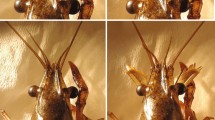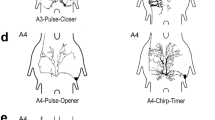Summary
-
1.
Auditory interneurons of the migratory locustLocusta migratoria were identified by intracellular recording and staining in the meso- and metathoracic ganglia. The response to (i) acoustic stimuli, (ii) movement of a hindleg and (iii) a combination of the two kinds of stimuli were analyzed.
-
2.
During acoustic stimulation (10 ms, 70 dB, pure tones at 4 or 12 kHz) the interneurons discharge 1–4 AP per pulse, with a latency of 10–25 ms (Fig. 1A, F; Fig. 4A, E).
-
3.
Sinusoidal rotation of a hindleg (frequency: 2.5–20 Hz, amplitude: 4 mm) elicits, in one group of interneurons, phase-coupled suprathreshold response (Fig. 1B, E) and in another group a subthreshold excitation (Fig. 4B).
-
4.
When acoustic and movement stimuli are presented simultaneously, both groups of interneurons show a general reduction of the auditory response (Fig. 1G; Fig. 4F). In those interneurons with suprathreshold responses to sound and movement the responses to the two kinds of stimuli show phase-dependent, reciprocal, influences (Fig. 1I, K; Fig. 3B, D).
-
5.
Interneurons with suprathreshold responses only to acoustic stimuli, fail to respond at certain phases of leg movement (Fig. 4I, J; Fig. 6B).
-
6.
Two possible mechanisms for the suppression of movement-coupled activity in the latter interneurons are discussed: (i) a general elevation of threshold and (ii) an inhibition by fibers with movement-specific responses.
Similar content being viewed by others
Abbreviations
- URP :
-
upper reversal point
- AP :
-
action potential
- St :
-
acoustic stimulus
- PST :
-
post-stimulus-time
- C :
-
cycle of movement stimuli
References
Glowatzki E, Schäfer A, Elsner N (1986) Vergleichende Untersuchungen über die Stridulations- und Ventilationsmuster verschiedener Feldheuschreckenarten. In: Elsner N, Rathmayer W (eds) Sensomotorik — Identifizierte Neurone. Beiträge zur 14. Göttinger Neurobiologentagung. Thieme, Stuttgart, p 127
Hedwig B (1984) Activity and deafness of auditory interneurons during stridulation in the grasshopperOmocestus viridulus L. Naturwissenschaften 71:380–381
Hedwig B (1986) On the role in stridulation of plurisegmental interneurons of the acridid grasshopperOmocestus viridulus L. II. Anatomy and physiology of ascending and T-shaped interneurons. J Comp Physiol A 158:429–444
Hedwig B (1988) Activation and modulation of auditory receptors inLocusta migratoria by respiratory movements. J Comp Physiol A 162:237–246
Hedwig B (1989) Modulation of auditory information processing in tethered flying locusts. J Comp Physiol A 164:409–422
Hedwig B, Elsner N (1985) Sound production and sound detection in a stridulating acridid grasshopper (Omocestus viridulus L.). In: Kalmring K, Elsner N (eds) Acoustic and vibrational communication in insects. Parey, Hamburg, pp 61–72
Hedwig B, Lang F, Elsner N (1988) The interference of sound and movement stimuli in tympanal receptors ofLocusta migratoria. J Comp Physiol A 163:243–252
Helversen O von, Helversen D von (1988) Innate receiver mechanisms in the acoustic communication of orthopteran insects. In: Guthrie DM (ed) Aims and methods in neuroethology. Manchester University Press, pp 104–150
Lang F (1985) Der Einfluß von Beinbewegungen auf das Verhalten akustischer Interneurone bei der WanderheuschreckeLocusta migratoria L. Diplomarbeit, Universität Göttingen
Marquart V (1985a) Auditorische Interneurone im thorakalen Nervensystem von Heuschrecken: Morphologie, Physiologie und synaptische Verbindungen. Dissertation, Universität Bochum
Marquart V (1985b) Local interneurons mediating excitation and inhibition onto ascending neurons in the auditory pathway of grasshoppers. Naturwissenschaften 72:42–44
Michelsen A (1971 a) The physiology of the locust ear. I. Frequency sensitivity of single cells in the isolated ear. J Comp Physiol 71:49–62
Michelsen A (1971 b) The physiology of the locust ear. III. Acoustical properties of the intact ear. J Comp Physiol 71:102–128
Murphey RK, Zaretsky MD (1972) Orientation to calling song by female cricketsScapsipedus marginatus (Gryllidae). J Exp Biol 56:335–352
Meier T, Wolf H, Helversen O von (1987) Auditory window for responsiveness during stridulation of grasshoppers recorded from one of their auditory interneurons. In: Elsner N, Creutzfeld O (eds) New frontiers in brain research. Proceedings of the 15th Göttingen Neurobiology Conference. Thieme, Stuttgart New York, p 85
Rehbein H (1976) Auditory neurons in the ventral cord of locusts: morphological and functional properties. J Comp Physiol 110:233–250
Rehbein H, Kalmring K, Römer H (1974) Structure and function of acoustic neurons in the thoracic ventral nerve cord ofLocusta migratoria (Acrididae). J Comp Physiol 95:263–280
Römer H, Marquart V (1984) Morphology and physiology of auditory interneurons in the metathoracic ganglion of the locust. J Comp Physiol A 155:249–262
Ronacher B, Römer H (1985) Spike synchronization of tympanic receptor fibres in a grasshopper (Chorthippus biguttulus L., Acrididae): a possible mechanism for detecting short gaps in model songs. J Comp Physiol A 157:631–642
Ronacher B, Helversen D von, Helversen O von (1986) Routes and stations in the processing of auditory directional information in the CNS of a grasshopper, as revealed by surgical experiments. J Comp Physiol A 158:363–374
Schildberger K, Milde JJ, Hörner M (1987) Effects of walking on auditory receptors and interneurons in crickets. In: Elsner N, Creutzfeldt O (eds) New frontiers in brain research. Proceedings of the 15th Göttingen Neurobiology Conference. Thieme, Stuttgart, p 82
Stewart W (1978) Functional connections between cells as revealed by dye-coupling with a highly fluorescent naphthalimide tracer. Cell 14:741–759
Wolf H, Helversen O von (1986) ‘Switching-off’ an auditory interneuron during stridulation in the acridid grasshopperChorthippus biguttulus L. J Comp Physiol A 158:861–871
Zarnack W, Möhl B (1977) Activity of the direct downstroke flight muscles ofLocusta migratoria (L.) during steering behaviour in flight. J Comp Physiol 118:215–233
Author information
Authors and Affiliations
Rights and permissions
About this article
Cite this article
Lang, F., Elsner, N. The interference of sound and movement stimuli in auditory interneurons ofLocusta migratoria L.. J. Comp. Physiol. 164, 697–706 (1989). https://doi.org/10.1007/BF00614512
Accepted:
Issue Date:
DOI: https://doi.org/10.1007/BF00614512




